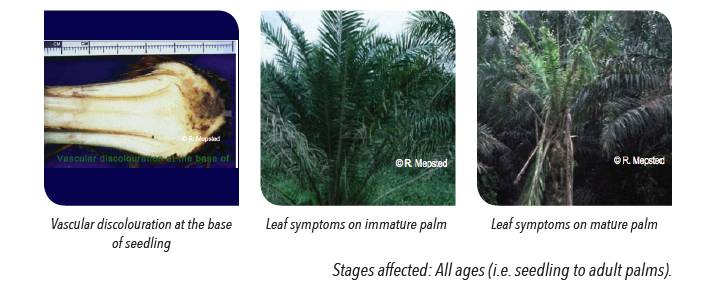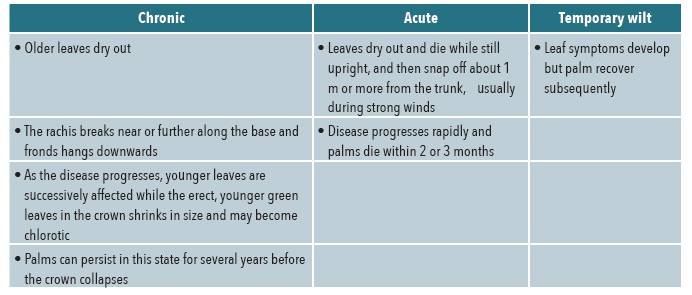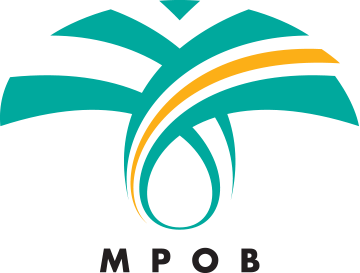General Information

In mature palms, the disease can manifest in various forms:

On immature palms, leaves in the middle of the crown become yellow or brown. The discolouration spreads to the lower leaves and the palm eventually desiccates and die.
At the nursery stage, infected palms show progressive shortening of younger leaves and desiccation and death of older leaves. These symptoms are thought to be caused by a combination of water stress (caused by xylem vessel blockage) and changes to plant gibberellin levels/activity.
Internally, this disease is characterised by discolouration and blockage of xylem vessels with tyloses and gums. Vascular discolouration (from healthy cream to infected dark brown) occurs in palm stems, and can spread systemically to the petioles in severely infected palms. Roots do not exhibit signs of infection even in highly diseased field palms.
Distribution
Africa, South America.
Detection and Inspection
Brown discolouration of xylem tissue in the trunk leaf bases of severely infected palms is diagnostic for this disease. Care must be taken to distinguish between brown xylem vessels and discolouration of the sclerenchyma tissue of vascular bundles, which can occur in old healthy palms or following attack by Ganoderma or Armillaria. Trunk samples can be obtained by felling the palm or preferably with an increment borer, which avoids destructive sampling of entire palms. Samples can be examined microscopically for Fusarium hyphae or vascular occlusion with gels or more reliably plated onto agar; the pathogen can also be isolated from seeds and pollen.
Infection can be confirmed by surface sterilisation of samples then plating onto Fusarium-selective medium. After 3-5 days, mycelium of F. oxysporum emerging initially from xylem vessels should be visible.
F. oxysporum can be diagnosed to species level at reasonable speed by DNA-based diagnostics using PCR with primers based on the translation elongation factor (TEF) gene. There is still a need to for pathotype (f. sp. elaeidis)-specific primers.
Prevention and Control
PHYTOSANITARY
Almost all batches of seed may be contaminated with F. oxysporum. The import of germplasm material (seeds, pollen, tissue culture) must be accompanied by an import permit issued by or on behalf of the Director-General Department of Agriculture for Peninsular Malaysia (including Labuan), or the Director Department of Agriculture for Sabah, and a phytosanitary certificate issued by an authorised official from the country of export. The import conditions are available upon request from the Plant Biosecurity Division Malaysia. All consignments are subjected to inspection by the Department of Agriculture prior to clearance by Customs. Germplasm material imported from high risk areas should be sent for third country quarantine before arrival onto Malaysian shores. The seed can be vacuum treated with a blend of fungicide carbendazim and prochloraz – administered under the pressure of 15 000 to about 8000 Pa with the aid of a wetting agent e.g. Tween 20.
CULTURAL CONTROL AND SANITARY METHODS
The pathogen persists on sites of previously infected palms. The diseases incidence can be reduced by planting new palms more than 2 m from old stumps. The application of potassium, and the removal of ground cover plant and plant debris/much would also help in reducing disease incidence.
Further reading
- CABI CPC (2015). Datasheet on Fusarium oxysporum f.sp. elaeidis. Url: http://www.cabi.org/cpc/
- Chinchilla, C and Guzman, N (2005). No known risk of pests or pathogen introduction through the import of oil palm clones from Costa Rica. ASD Oil Palm Papers (28): 1-4.
- Cooper, R M and Rusli, M H (2014). Threat from Fusarium wilt disease of oil palm to Southeast Asia and suggested control measures. J. Oil Palm Res. 26(2): 109-119.
- Corley, R H V and Tinker, P B (2003). The Oil Palm 4th ed. Blackwell Science Ltd: USA. p. 402-407.
- Flood, J (2006). A review of Fusarium wilt of oil palm caused by Fusarium oxysporum f.sp. elaedis. Phytopathology, 96: 660-662.
- Omamor, I B; Asemota, A O; Eke, C R and Eziashi, E I (2007). Fungal contaminants of the oil palm tissue culture in Nigerian Institute for Oil Palm Research (NIFOR). African J. Agric. Res. 2(10): 534-537.
- Osagie, I J; Ojomo, E E and Maduewesi, A E (2013). Physiological studies on ten isolates of the oil palm pathogen, Fusarium oxysporum f.sp.elaeidis. Nigerian J. Agric., Food & Env. 9(1): 33-39.
- Rusli, M H; Idris, A S and Balia Yusof, Z N (2013). Fusarium vascular infection of oil palm: Epidemiology, molecular diagnostic tools and the potential of Fusarium suppressive soil in Malaysia. J. Environ. Sc. Eng. B2: 578-585.
- Rusli, M H; Idris, A S and Cooper, R M (2015). Evaluation of Malaysian oil palm progenies for susceptibility, resistance or tolerance to Fusarium oxysporum f. sp. elaeidis and defence-related gene expression in roots. Plant Pathology, 64: 638-647.
- Rusli, M H; Idris, A S and Cooper, R M (2016). Evaluation of Malaysian soils for potential suppressiveness of Fusarium wilt of oil palm caused by Fusarium oxysporum f.sp. elaeidis. J. Microb. Biochem. Technol. 8: 459-464.

